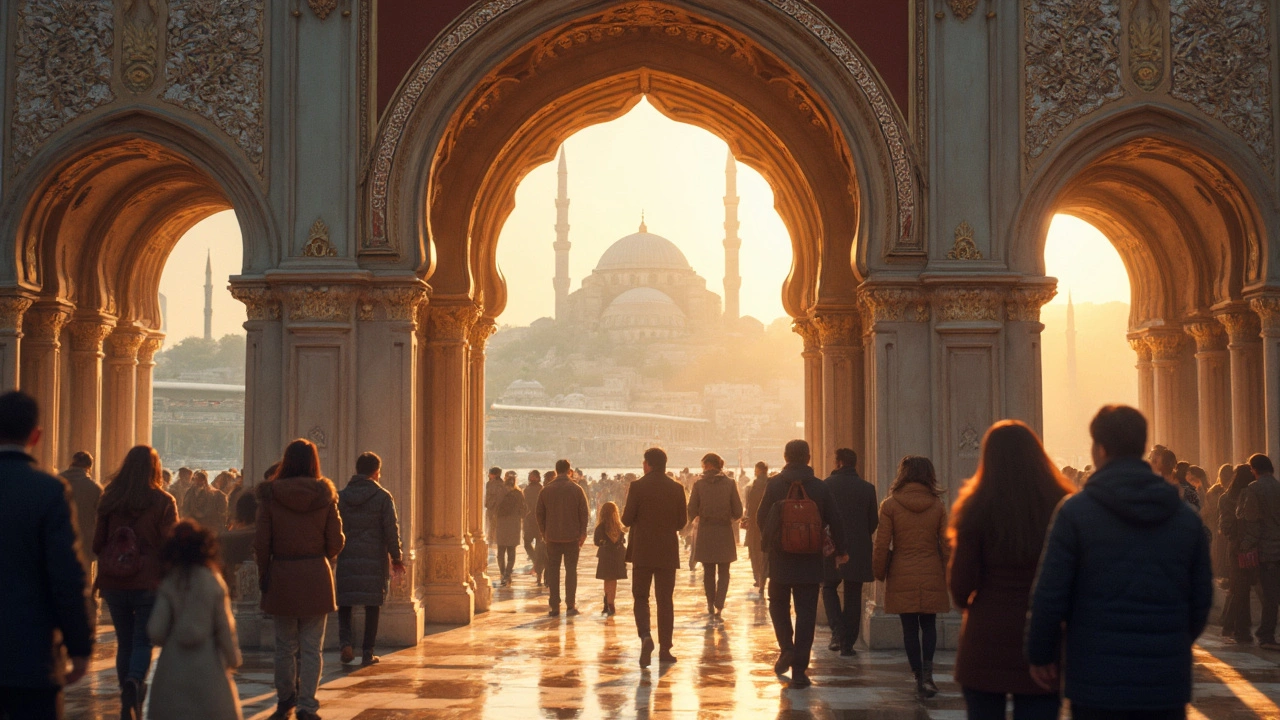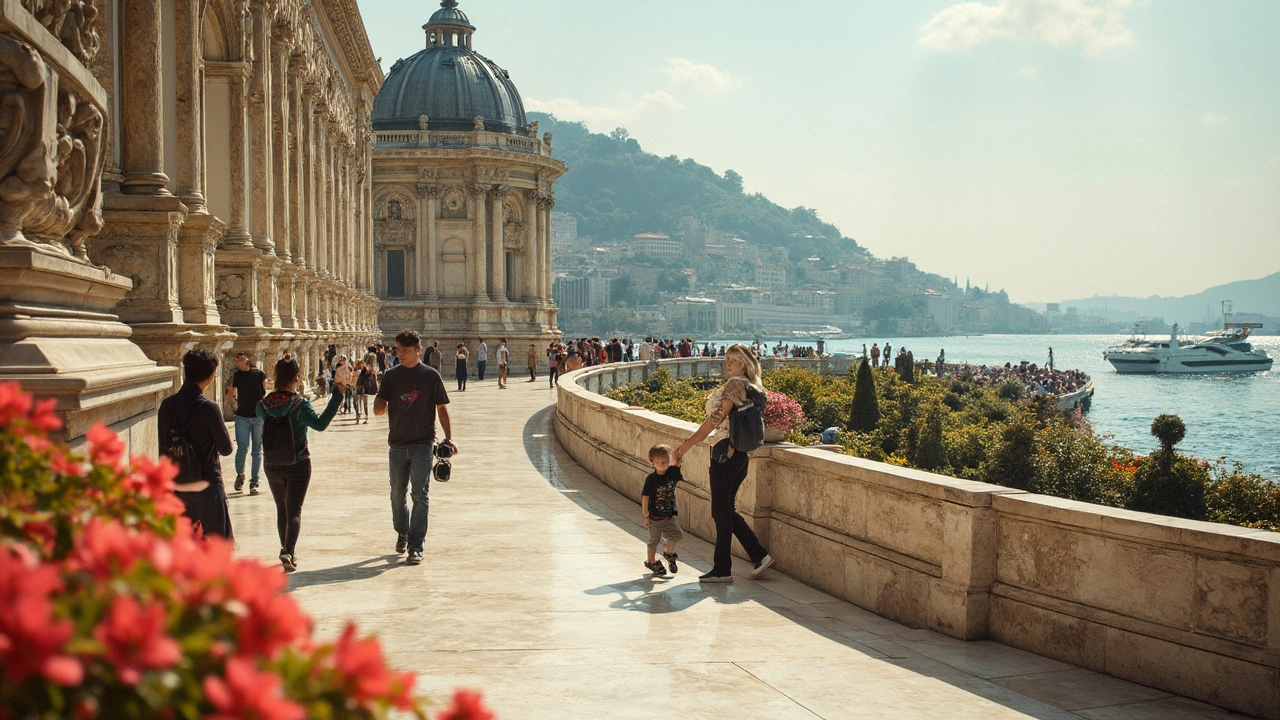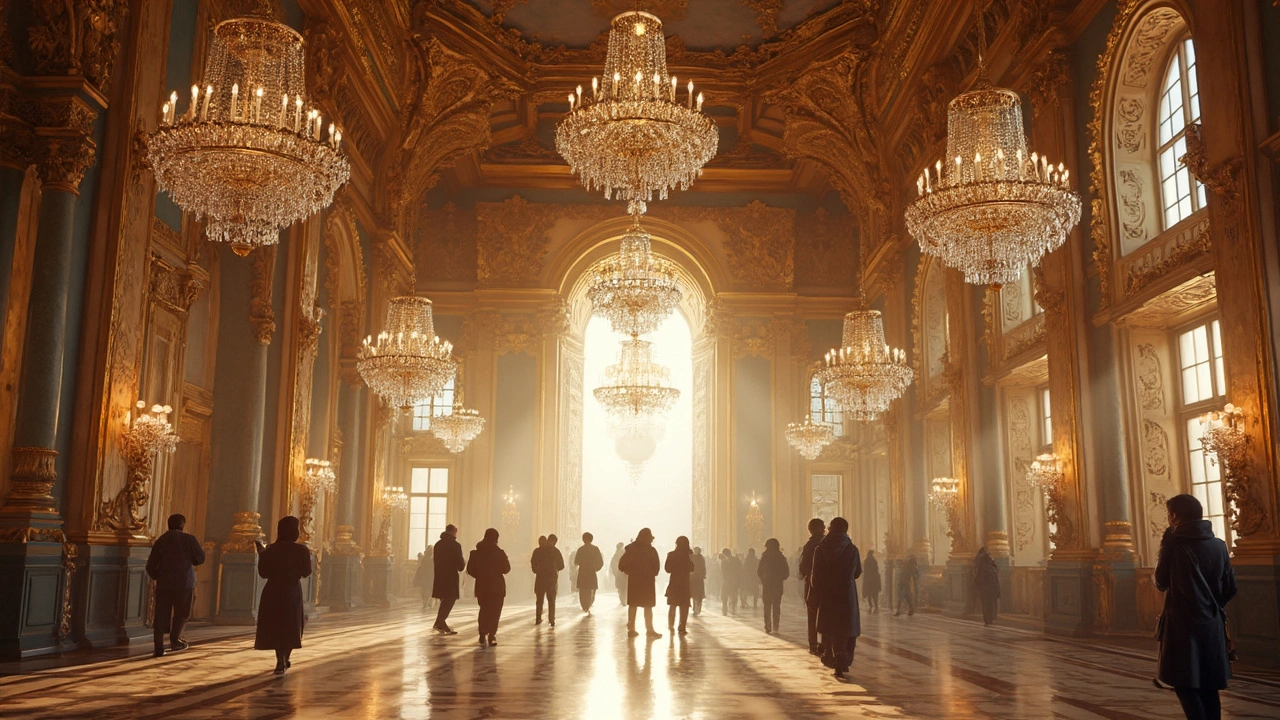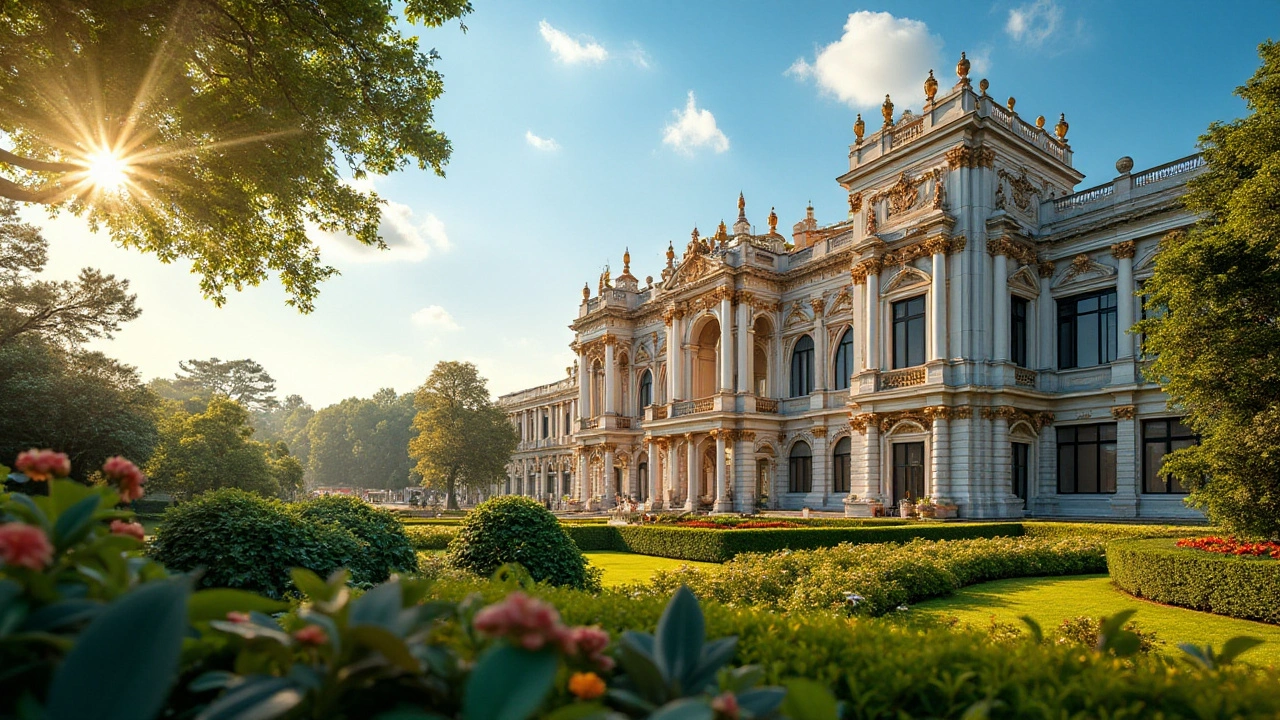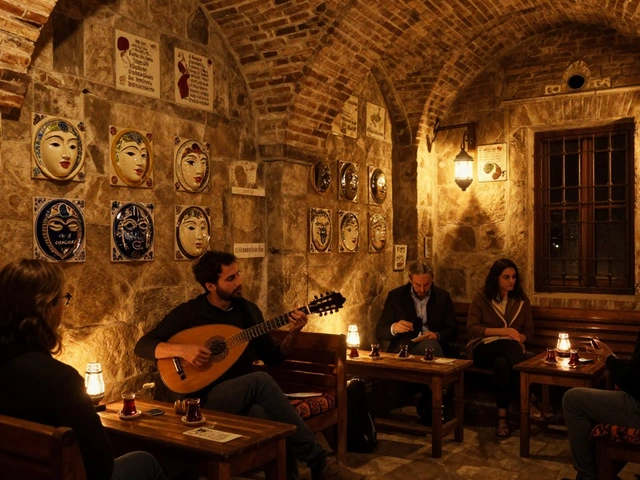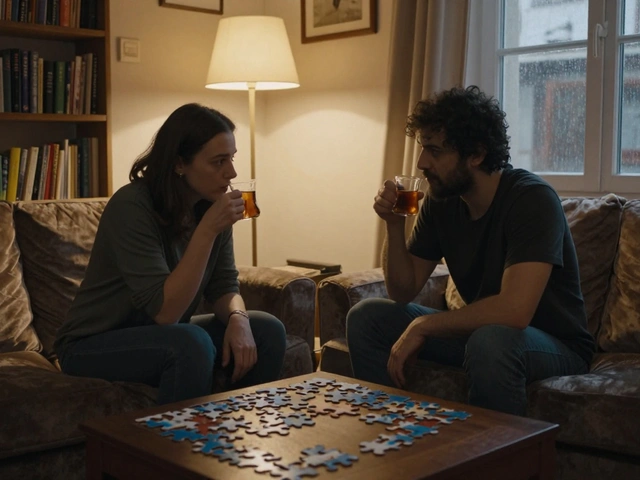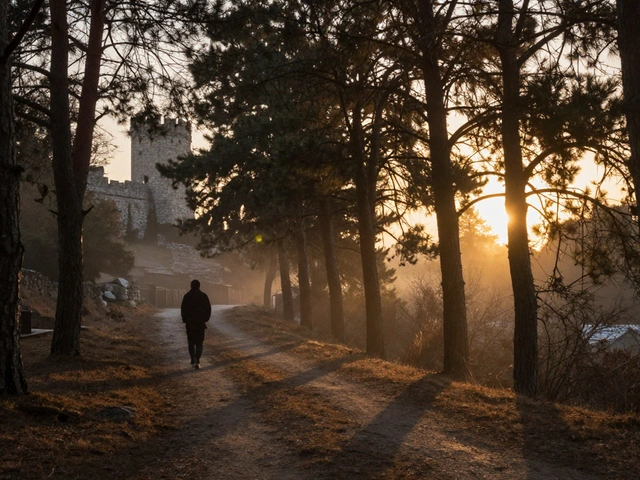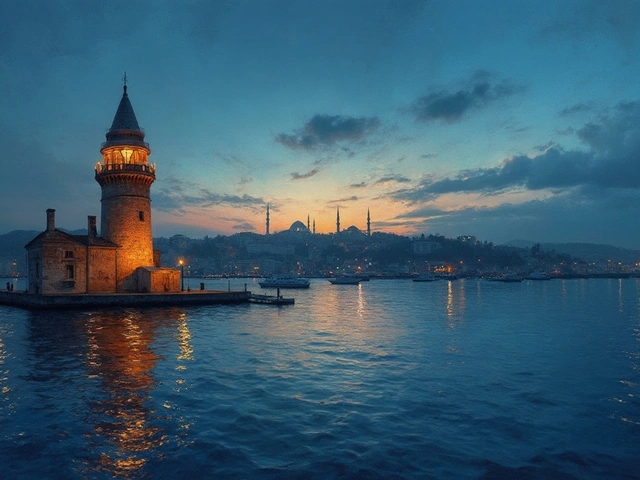You don’t need to be a history buff to get swept away by Dolmabahçe Palace. One glance at its glittering halls and you’ll see why this spot tops so many Istanbul must-see lists. The moment you step inside, you can’t help but wonder how many pairs of shoes have clacked across those endless marble floors—seriously, the place is bigger than some neighborhoods.
Some rooms here make Versailles look basic. The crystal staircase is probably the most Instagrammed spot, and if you’re into chandeliers, the palace boasts one of the largest on earth—it’s so heavy, I doubt even Max could drag it across the room. Travelers love marveling at the gold-leaf ceilings and furniture straight out of an Ottoman sultan’s wish list.
You’ll find clear rules (no snapping pics in the main halls, but plenty of photo ops outside) and a steady stream of tours in different languages. The vibe is half movie set, half super-size dollhouse—except every detail is real and plenty of it is wildly over the top. You don’t have to rush, but it pays to hit the big-ticket sights first before crowds pile in. Don’t worry—this guide will help you pick your path, skip the biggest lines, and spot the quirkiest details that most people miss.
- Top Highlights at Dolmabahçe Palace
- Why Dolmabahçe Palace Stands Out
- How to Visit Like a Pro
- Dolmabahçe vs. Other Istanbul Palaces
Top Highlights at Dolmabahçe Palace
There’s no shortage of wow-factor spots inside Dolmabahçe Palace. If you’re planning just a quick visit, these are the absolute must-sees. Missing them would be like skipping pizza in Naples or sushi in Tokyo. Here’s what you can’t leave out:
- Crystal Staircase: Forget basic staircases—this one’s all about glass, brass, and glamour. Its banisters are pure Baccarat crystal. Visitors crowd around for photos, but for good reason: the sunlight pouring in lights them up like a chandelier.
- Ceremonial Hall (Muayede Salonu): This is the palace’s showstopper. The hall is massive—about 2,000 square meters—and capped with the world’s largest Bohemian crystal chandelier, weighing a wild 4.5 tons. That’s more than most cars.
- Atatürk’s Room: History gets personal here. Mustafa Kemal Atatürk, founder of modern Turkey, spent his last days in this room. The clock is stopped at 9:05, the exact time he passed away in 1938. Locals treat this spot almost like a shrine—expect a quieter vibe.
- Harem Section: It’s totally different from the public areas, with winding corridors, cozy rooms, and private courtyards. They used to keep this area strictly off-limits. You’ll feel the difference the second you enter: the vibe gets way more intimate.
- Palace Gardens: Even if you’re not a flower person, these gardens are worth a stroll. Fountains, peacocks, and a postcard-ready Bosphorus backdrop hit all the right notes for a chill break or killer selfies.
If you’re the stats-loving type, check this out:
| Highlight | Fun Fact |
|---|---|
| Crystal Chandelier | Weighs 4.5 tons with 750 bulbs |
| Number of Rooms | 285—good luck seeing them all |
| Palace Length | 600 meters along the Bosphorus |
| Crystal Staircase | Pure Baccarat glass and gilded brass |
| Atatürk’s Room Clock | Frozen at 9:05 am, 10 Nov 1938 |
Set your plan around these highlights to get maximum impact from your trip. They’re not just pretty—they come packed with stories, and snapping pics here is like capturing little slices of Istanbul’s wild history.
Why Dolmabahçe Palace Stands Out
If you compare Dolmabahçe Palace to other historic spots in Istanbul, this one jumps out fast. First off, it’s the biggest palace in Turkey—more than 285 rooms and 68 bathrooms! The place takes up about 45,000 square meters right along the Bosphorus, so you get waterfront views that make other royal digs jealous.
The architecture is totally unique. It mixes Ottoman style with European vibes—think Baroque, Rococo, and Neoclassical all crammed together and somehow making sense. No wonder every corner looks like it was made to impress foreign ambassadors and show off a new era of the Ottoman Empire.
- Chandeliers: The world’s largest Bohemian crystal chandelier beams down in the main hall. It weighs a mind-blowing 4.5 tons, with 750 lamps sparkling overhead. People come just to see this light show.
- Staircases: That wild crystal staircase? All cut glass and brass—tourists line up for a closer look and quick selfies.
- History: This was the Ottoman sultans’ main pad from 1856 onward. Even Mustafa Kemal Atatürk, the founder of modern Turkey, used it later. He actually passed away in one of the rooms in 1938, which you can still visit (the clock’s stopped at 9:05, the exact time of his death).
Back in the 19th century, Dolmabahçe was like Istanbul’s answer to Buckingham Palace. The sultans wanted to outshine Europe and prove they could do luxury just as well, if not better. Here’s one thing I didn’t expect: the palace had electricity, running water, and a central heating system surprisingly early for its time. The Ottomans weren’t messing around when it came to tech.
| Feature | Dolmabahçe Palace | Topkapi Palace |
|---|---|---|
| Built | 1856 | 1478 |
| Size | 45,000 m² | 80,000 m² (but more spread out) |
| Main Style | European + Ottoman | Classical Ottoman |
| Main Use | 18th-20th c. Sultans | 15th-17th c. Sultans |
| Wow Factor | Chandeliers, luxury interior | Courtyards, Harem |
Unlike a lot of grand old buildings, Dolmabahçe kept up with the times. Blending old-school Ottoman flair with fresh European tricks, it was the heart of Turkish politics and royal living for decades. That’s what makes it a must-see—there’s nothing else in Istanbul quite like it.
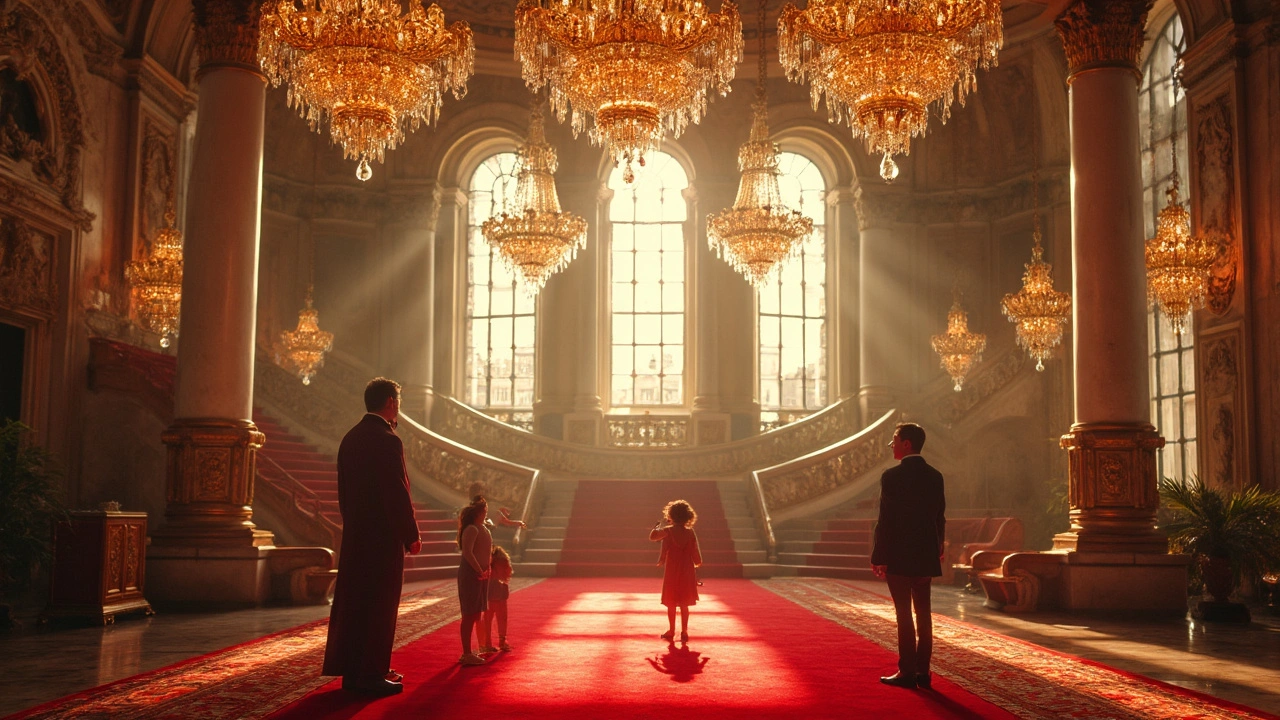
How to Visit Like a Pro
So you want to get the most out of your trip to Dolmabahçe Palace? A little planning goes a long way here. This isn’t one of those places you just stumble into—there are real lines, ticket checks, and crowds to deal with, especially on weekends or holidays. But, with a few tricks, you can cruise past the headaches and really take in the sights.
First off, buy your tickets online ahead of time. The official website and the Ministry of Culture’s kiosks let you reserve a spot. Showing up without a ticket can mean waiting over an hour—no joke. They don’t allow entry 90 minutes before closing, and admission usually stops at 4 p.m. The palace is closed on Mondays, so plan around that.
Next, show up early. Doors open around 9 a.m., but the big bus tours roll in around 10. If you’re there first, you wander the Dolmabahçe Palace halls before they fill up. A weekday visit is way less stressful than weekends. And don’t forget, you’re required to wear shoe covers (they provide them at the door). It feels a bit silly but saves those fancy old floors for everyone.
- Photography is only allowed outside, so snap exterior shots before heading in. No point arguing with the guards—they mean it.
- Bags get checked, and you can’t bring big backpacks inside. Leave the heavy stuff at your hotel.
- Dress modestly—it’s not a mosque, but you’ll feel more comfortable and respectful in long pants and covered shoulders.
- The security lines can bottleneck during peak times, so keep your ticket and ID handy.
Plan for about 2-3 hours inside. If you’re interested in the gardens, harem quarters, or the Clock Museum, budget extra time. Restrooms are limited, and there’s no food inside—grab a snack beforehand or hit up a nearby café after. Pro tip: bring a bottle of water (small ones are allowed), especially in warmer months.
Check out this quick-reference table for common visitor stats:
| Entrance Fee | Opening Hours | Closed Days | Avg. Visit Time |
|---|---|---|---|
| 650 TL (2025) | 9:00 – 17:00 | Monday | 2–3 hours |
Last tip: The gift shop outside has cooler souvenirs than most tourist traps. If you want something with the palace crest, don’t leave it till your last Istanbul day.
Dolmabahçe vs. Other Istanbul Palaces
When people talk palaces in Istanbul, most folks think of Dolmabahçe Palace or Topkapi Palace first. So what sets Dolmabahçe apart from the others? Easy: Dolmabahçe is where east bumped right into west—hard. It’s loaded with European styles (think Versailles-level glam) but still hangs on to the last whispers of Ottoman tradition.
Unlike Topkapi, which is basically hundreds of rooms and courtyards all jumbled together, Dolmabahçe feels more like a mansion straight out of a royal reality show. Everything is bigger, shinier, and more modern—at least by 19th century standards. Fun fact: Dolmabahçe has Turkey’s biggest ballroom, and its main chandelier weighs over four and a half tons. That’s something you don’t see at the older palaces.
Beylerbeyi Palace, sitting across the Bosphorus, is on the smaller side but has insane views. It was the ultimate summer house for Ottoman sultans. Çırağan Palace serves up five-star hotel vibes nowadays—not really a museum experience anymore, but cool for brunch and riverside photos.
| Palace | Main Draw | Era | Style |
|---|---|---|---|
| Dolmabahçe Palace | Insane chandeliers, crystal staircases, modern Ottoman luxury | Mid-1800s | Ottoman-European mix |
| Topkapi Palace | Ottoman relics, Harem, old school courtyards | Late 1400s-1800s | Classic Ottoman |
| Beylerbeyi Palace | Bosphorus views, seaside pavilions | Mid-1800s | Neoclassical/Baroque |
| Çırağan Palace | Luxury hotel, iconic bridge-side location | Late 1800s | Ottoman Baroque |
Here’s another thing: you won’t feel the same hush-hush palace energy at Dolmabahçe as you get at Topkapi. At Dolmabahçe, you walk through glitzy halls that once wowed foreign leaders—from Franz Joseph to Queen Victoria’s cousin. Topkapi, on the other hand, is all about the hidden stories and treasures—think secret rooms and the Sultan’s legendary spoon-maker’s diamond.
Visiting Dolmabahçe is much less confusing. There’s a single main route, audio guides in different languages, and most of what you want to see is inside one structure (which is a life saver if you’re rushing). Topkapi’s labyrinth of courtyards? Way trickier to navigate. And if you’re in it for epic selfies, Dolmabahçe’s grand staircase and sparkling décor win, hands down.
Bottom line: if you want traditional Ottoman history, Topkapi is your stop. But if your jaw drops for chandeliers, gold trim, and a taste of Istanbul’s golden years, Dolmabahçe Palace is tough to beat.
